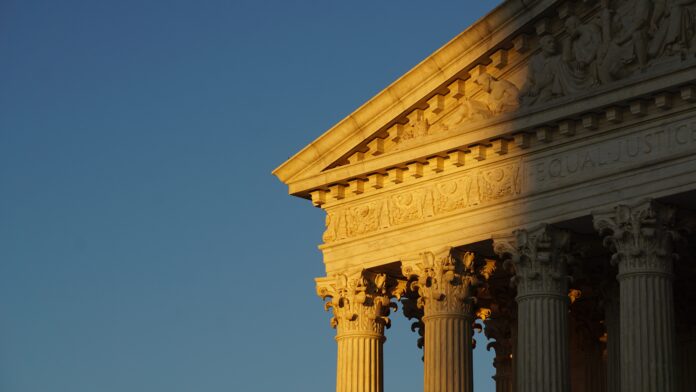![]()
With Politico’s leak of Justice Samuel Alito’s apparent majority opinion in Dobbs v. Jackson, many have concluded that Roe v. Wade and Planned Parenthood v. Casey will be struck down, sparking nationwide protests and anger. Setting aside the uproar for a moment, however, this article aims to logically and objectively trace Alito’s opinion, outlining his thought process as plainly as possible. Hence, page citations have been included for the purpose of reference if desired.
First, it is worth refreshing our memories as to what were the central holdings in Roe and Casey. Under Roe, a state cannot constitutionally protect fetal life pre-viability, which is the earliest point at which the fetus can survive outside the womb. Casey then forbids states from adopting any law which imposes an “undue burden” on the right to obtain an abortion. (3, 4)
The rationale for Roe centers around the fact that the right to abortion is “a component of the ‘liberty’ protected by the Fourteenth Amendment’s Due Process Clause,” which says that “no state shall deprive any person of life, liberty, or property without due process of law.” (9)
Alito explores the history of the following question: does abortion constitute a substantive right protected by the Due Process Clause? For the answer to be yes, he says that abortion must be “deeply rooted in [our] history and tradition” and part of our “scheme of ordered liberty.” (11)
To answer this, the Justice asserts that “until the latter part of the 20th century, there was no support in American law for a constitutional right to obtain an abortion. Zero. None.” (15) Furthermore, he notes that “when the Fourteenth Amendment was ratified, three-quarters of the States, 28 out of 37, had enacted statutes making abortion a crime.” (23) By the end of the 1950s, all but four states and the District of Columbia had passed laws prohibiting abortion with the exception being when the mother’s life is in danger. This historical description—one which is included in Roe and which the respondents in Dobbs do not attempt to repudiate—thus disproves the notion that abortion is deeply rooted in our history and tradition, according to Alito. (24)
Additionally, Alito rebuffs several ancillary arguments made in favor of upholding Roe. One argument, for example, claims that a historical distinction during pregnancy called “quickening” existed and was used to validate the current bans on pre-viability abortions; in response, the Justice claims that states never codified that distinction into law and always penalized pre-quickening abortions. Furthermore, some argue that state abortion statutes were illegitimately enacted anyway; Alito dismisses this, saying that the Supreme Court has long avoided using a law’s motives as supporting evidence in a case. (27-28)
Alito rejects the argument that abortion is part of a broader “right to define one’s own concept of existence, of meaning, of the universe, and of the mystery of human life.” While an individual may freely think and speak as they wish, “they are not always free to act” since not every action comports with an ordered liberty that “sets limits and defines the boundary between competing interests.” (30-31) In supporting that broader right, respondents frequently cite one’s right to obtain contraceptives, engage in private consensual sexual acts, or marry someone of another race, of the same sex, or while in prison. To Alito, none of these involve “the critical moral question posed by abortion,” as abortion terminates life or potential life. Those cases would thus not affect Dobbs, and likewise, Dobbs would not affect those cases. (32)
Do “changes in society require the recognition of a constitutional right to obtain an abortion?” (33) Parties on both sides respond to this question by making primarily policy-based arguments, but most state that Roe and Casey supporters must present arguments strong enough to dictate direct federal regulation. Alito remarks: “They have failed to make that showing, and we thus return the power to weigh those arguments to the people and to their elected representatives. (34-35)
Does precedent then compel the continued acceptance of Roe and Casey? Alito admits that precedent is in fact important for the proper consideration of judicial power, but it is not absolute, and it is ultimately more important that the Court settle an issue right, than that it just settles it for the sake of putting it to rest. (35-36) When, then, should the Court overturn precedent? For Dobbs, Alito relies on five factors which are worth elucidating.
First is “the nature of the Court’s error.” Roe was not only “egregiously wrong and deeply damaging” but marked a judicial usurpation of power from the democratic process. (39-41)
Second is “the quality of the reasoning, ” which was especially weak in Roe and had little factual basis in text, history, or precedent, such that even the majority opinion in Casey barely endorsed it, according to Alito. The Court then imposed an intricate yet arbitrary set of regulations based on trimesters and viability which have been tough to justify even for pro-choice philosophers, ethicists, and scholars alike. (41-42, 47, 50)
Third is “workability.” Is a Court-imposed rule easily understood and applicable in a “consistent and predictable manner?” In the case of Casey’s “undue burden” test, the answer is no. (52) The rules supporting that test contain vague terms, such as “substantial,” “unnecessary,” and “undue”; as a result, various Justices and Courts of Appeals have come to very different conclusions in their application of the same test. (54-56)
Fourth is its “effect on other areas of law.” Roe and Casey have distorted many other legal doctrines which have required “courts to engineer exceptions to longstanding background rules.” The two cases thus betray the goal of precedent, which is to make the development of law coherent and intelligible. (59)
Fifth are “reliance interests.” Do certain individuals currently rely on Roe and Casey such that there would be immediate and concrete costs for them right now if those cases were overruled? Since—according to Alito—getting an abortion is generally an unplanned response to an unplanned activity and reproductive plans can change promptly in response to a change in the law, the answer is no. A more general reliance interest based on “the effect of the abortion right on society and…on the lives of women” is hotly debated and not easily determinable by the Court. (60-61)
Finally, Alito addresses institutional distrust in the Supreme Court, especially given the popular view that the leaked Roe decision was made under political pressure. (62) Though it is important that the public sees the Court’s decisions as based on principle, Alito argues that they cannot “be affected by any extraneous influences such as concern about the public’s reaction to our work.” (63) The Court’s sole responsibility and authority is to “judge what the law means and how it should apply to the case at hand.” (64)
With all that said, Alito concludes “that the Constitution does not confer a right to abortion.” (65) If Roe and Casey are, in fact, overturned, the standard of rational basis review will govern future cases deciding whether abortion restrictions pass constitutional muster. To pass, a state will need to present a legitimate government interest that is rationally linked to the statute in question.
To reiterate, the goal of this article is to give a concise explanation of Alito’s draft opinion; it is not to commentate on its merits or faults. It must also be remembered that this draft opinion is not a final opinion. It is both possible and likely that the final opinion will be significantly different than what is described here.












